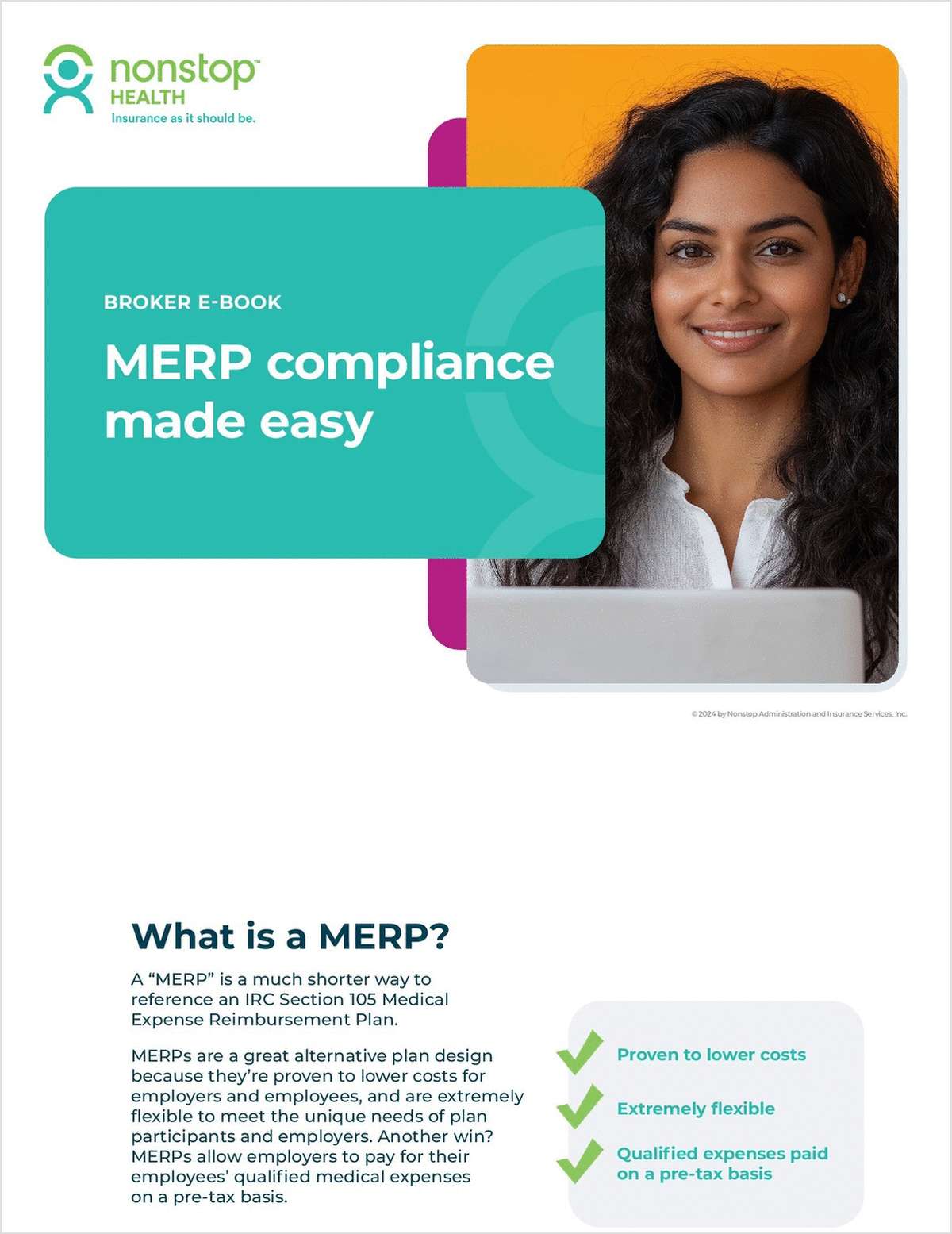 Imagine a situation like this: There are several people involved in making a decision about a health plan. Each has a different perspective on how to evaluate the plan and as they focus on it, they realize they all have different goals for what they want the plan to accomplish.
Imagine a situation like this: There are several people involved in making a decision about a health plan. Each has a different perspective on how to evaluate the plan and as they focus on it, they realize they all have different goals for what they want the plan to accomplish.
In this article, I present a simple four-question model for advisors and clients evaluating a health plan so that the people within the organization use a common goal to guide decisions. Everyone on the team involved in making the decisions at the client level should go through this model to avoid the tug of war that often occurs.
|1. What is your current PEPY and what do you want it to be?
The per employee per year (PEPY) is the claims cost, medical, and pharmacy claims combined. It is the allowed amount, not the paid amount. Suppose the organization is moving toward a complete coverage health plan so they can waive deductibles and copays to make health care free for their employees. The reason to look at the allowed amount is that it will eventually become their entire responsibility. They will take on both the plan and the patient responsibility when they move into at 100 percent coverage model.
A second reason relates to Milliman Care Guidelines (MCG) as the benchmark for measuring the plan's performance. This is a more reliable benchmark than a book-of-business comparison. A book-of-business comparison is like going to a support group meeting and saying, “Yes, I'm broken, but I'm not as broken as that guy.” Generally speaking, the health care system is horribly broken across the board. The MCG data shows the gold standard, best in class. Here is what we should be striving for. We know it's attainable, because they've gone through all of the analysis and applied all the actuarial methods.
Always try to compare your group's performance to a gold standard, evidence-based criteria or an MCG type of benchmark, not necessarily to a book-of-business benchmark.
MCG defines PEPY as medical and pharmacy claims combined allowed amount. There are other definitions for PEPY. Avoid becoming confused by other measuring methods, such as per member per month (PMPM), per member per year (PMPY) or per participant per year (PPPY). Make sure that you understand the units of measure.
In 2016, the MCG national average was $11,000; it was close to $12,000 in 2017 and in 2018 it was just short of $17,000. A company management team who does not know their PEPY needs to determine that number or hire a consultant to dig through the data to determine it.
For example, the PEPY on our well-managed PPO book-of-business is still running at about $6,500 PEPY and has been pretty stable for a number of years now. Clients who make that transition often go from a very loosely managed or even an unmanaged environment to a well-managed environment.
There are different levels of aggressiveness applicable for determining medical necessity and appropriateness. In a well-managed environment, a male patient would need plain film x-rays first before an MRI of the spine. He would have failed at least six weeks of conservative treatment (physical therapy, medications, weight loss, if appropriate). The certification would be denied if a health care provider ordered an MRI of the lumbar spine after the patient did just four weeks of conservative treatment consisting only of medication.
In a moderately managed plan, the certification might be given after four weeks of medication. The patient will be close to six weeks by the time he gets the imaging done anyway, so we'd let that one slide through.
The administrator of a loosely managed plan would probably certify the MRI and move on to the next case.
Guiding the location of testing is another aspect of how tightly a plan is managed. A well-managed plan's care manager directs the patient to the least costly location of the MRI machine. In a moderately managed plan, the outpatient setting would be ideal, but there could be some flexibility. A loosely managed plan care manager would not aggressively push for the test to be done at a freestanding facility.
Although $6,500 is a benchmark, if your group is spending over $6,500 PEPY, they're probably overspending. It is possible to reduce this number by moving a plan in a PPO environment to a transparent TPA, carving out the medical management and utilization of a comprehensive care management strategy.
Additional figures:
- Our RBP book-of-business performs at about $4,500.
- Among those who are doing direct contracting with bundled surgical pricing, carve out imaging, EAPs, medical tourism and even cash pay pricing, the book-of-business performs between $2,500 and $3,200 PEPY.
Where does the group want their PEPY in the future? Understanding where a group is performing today on their PEPY claims cost and what target number they want in the future is important.
|2. What is the noise level that you're able to tolerate in accomplishing that PEPY?
Any change is going to generate noise. Heck, even no change can generate noise! The more aggressive the new process, the more resistance employees show and the greater the potential of issues with low morale and productivity. Executives ask:
- “How are my employees going to react?”
- “Is this going to be disruptive?”
- “Are people going to be lined up out my door complaining about our new health insurance?”
Here's what people undertaking this endeavor need to understand: PEPY and noise are inversely proportional to each other. When your noise is very low, it's generally because you're loosely managing the process by paying for every procedure or service. Your PEPY is high. Noise increases when a company tightens management of the plan. The faster a company clamps down on health insurance plan costs, the more the noise goes up.
The laws of gravity dictate what goes up must come down. In most instances, there are quick responses in relevel settings. Even if the group decides it's going to cut its PEPY in half as of yesterday, that noise will skyrocket. But pretty quickly, it will come back down, usually within about 90 days. Most of the noise you are afraid you're going to experience will not materialize; that's what the data shows.
Companies can mitigate noise by managing a good open enrollment and having a positive spin in helping people understand the goal is to get them the right care at the right time at the right place. The right price is generally the natural consequence. The noise is much lower in a one-on-one open enrollment. The engagement is double when you have done a one-on-one open enrollment, so consider that as a noise mitigation strategy.
Some noise is necessary and a good thing. The insurance carrier is touching 1 percent of your population. A more well-managed model is to contact 20 percent of the population, because they're driving 80 percent of the claims. When all of a sudden 20 times the number of people are getting contacted compared to previously, there will be some noise. A well-managed model involves more reach out to people, connecting with them, asking questions and probing and pushing them to think a little bit differently about their health plan.
The question becomes, “How much noise are you willing to endure or tolerate? What is your noise threshold for achieving the desired PEPY?” It is critical you understand this threshold. It is not possible to cut the PEPY in half without generating reactions from employees. Be skeptical of a vendor who promises this.
Don't necessarily think of noise as a bad thing, but do make sure that you get an understanding of what noise level is tolerable.
|3. How quickly do you need to get to the target PEPY?
Slowly reducing PEPY may result in minimal noise. But what if the company needs to quickly conserve dollars by rapidly reducing PEPY? That need requires a set of vendors who are skilled in achieving that solution. Reference-based pricing will probably be part of that process.
Understanding the timing of how quickly they need to get there is really critical. It dictates which vendors/solutions need to be involved. The deadline also drives response time from vendors and consultants. An urgent need affects the data collection and planning process significantly.
|4. Is this new approach going to be something that you would benefit from, support and enjoy?
This question should be directed to the decision maker in the C-Suite. Suppose the health plan consultant puts together a strategy, pulls all the vendors together, presents the plan to the client, and gets approval. Then the decision maker or her family who has a need for the insurance benefits suddenly recognizes what they suddenly perceive as its limitations. When that happens, the leader's dissatisfaction contaminates the organization's culture.
Preempt the situation by asking the decision-maker, “OK, as I understand it, we want a solution that delivers a PEPY of X within this amount of time with this level of noise tolerance. When I bring you that solution, how is it going to impact you personally and how are you personally going to respond when this applies to you or to one of your family members?”
Practice that question, because when the decision-maker or someone in their family becomes sick, they may decide they want to be able to choose what they perceive to be the best site for care, and it may not be covered in the plan, or may be covered at a lower level. When they decide they're going to go to 'Facility X' because in their mind that's the best place (often because it has a great marketing budget, not always because of objective quality and cost data says it's the best) and others in the company see this behavior, it will affect the culture of the entire organization, and the overall outcome of the program.
Imagine the conflict that arises when a care management nurse tries to direct the patient to somewhere that has higher quality and lower cost. The best success occurs when the decision makers understand the implications of the plan and can say, “I would use this personally. I like this. This would be good for me and my family.”
To recap, the four questions are:
- “What is the PEPY versus what do you want it to be?”
- “What is the noise level that you're able to tolerate in accomplishing that PEPY?”
- “How quickly do we need to get to that target?”
- “Is this going to be something that you personally would benefit from, support and enjoy?”
Master the ability to ask these questions and you will master the process of helping a company decide on the best plan for them.
Deborah Ault, RN, CCM, CCP, AATMC, BCPA, MBA – AKA Nurse Deb – is Founder and President of Ault International Medical Management, LLC (AIMM). Her company provides independent comprehensive carve out concierge and patient advocacy-based utilization management, care management, disease management, and population health strategies to self-funded major medical health plans or those seeking to become self-funded. Reach Deborah at [email protected] or www.aim-m.com
Complete your profile to continue reading and get FREE access to BenefitsPRO, part of your ALM digital membership.
Your access to unlimited BenefitsPRO content isn’t changing.
Once you are an ALM digital member, you’ll receive:
- Breaking benefits news and analysis, on-site and via our newsletters and custom alerts
- Educational webcasts, white papers, and ebooks from industry thought leaders
- Critical converage of the property casualty insurance and financial advisory markets on our other ALM sites, PropertyCasualty360 and ThinkAdvisor
Already have an account? Sign In Now
© 2024 ALM Global, LLC, All Rights Reserved. Request academic re-use from www.copyright.com. All other uses, submit a request to [email protected]. For more information visit Asset & Logo Licensing.








